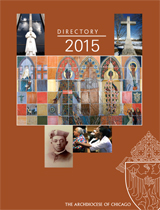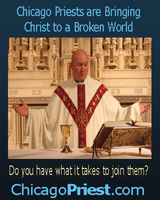January 20, 2008
Around the world’s religions Suburban sixth-graders get a whirlwind tour of faiths
The sixth-grade students of St. Mary School in Riverside pad quietly up the stairs, through a hallway and into a temple building at the Chicago Greater Hindu Temple in Lemont. They gather in a room with shrines to various deities set into the walls, and watch quietly while a priest with a towel around his waist bathes one of the statues of the deities.
The guide explains who the various deities are, and that they have more than one name. The way they are worshipped also varies by geographical region, he explains, because the practice of Hinduism grew up over more than 6,000 years in local communities that did not always have much contact with one another.
“Hinduism is not an organized religion,” he said. “It is just a way of life in India.” After leaving the room with the shrines, the students pad in their stocking feet to the cafeteria, where they unpack lunches that do not include any animal products, out of respect to their vegetarian hosts.
Along the way, teacher Susan Lachowicz reminds them how what they saw and heard relates to what they have learned about Hinduism: It’s the oldest of the major world religions, its sacred books are the Vedas and followers worship many gods. They believe in karma and reincarnation, but their recipe for a moral life is not that different from a Christian’s.
The students are on a field trip for their social studies class where they are studying world religions.
Shoeless again
After lunch, the students retrieve shoes and coats and board the bus to go to the Burhani Park Mosque in Hinsdale.
Once there, they again take off their shoes and hang up their coats, and walk into a carpeted gathering space. After a few moments looking at a display about the Shi’ite sect’s spiritual leader, they settle down to listen to Rashida Dahodowala, a mosque member who shares her experience and quizzes them on their knowledge of Islam.
“What’s that in the photograph?” she asks, pointing to a picture of Mecca during the Hajj. “It’s the Kabaa.”
The stone marks the place where Adam is supposed to have come when he had to leave paradise, she explains.
After discussing Islamic worship practices, the students are allowed to enter the prayer room on the first floor, where the men and boys pray. Then they go upstairs, to the galleries for women and girls and small children of both sexes. Dahodawala explains that when there is a speaker giving a religious discourse—the talks can go on for more than two hours—she spies on her young sons from the gallery.
“The rules say they [men] can’t look at us,” she explained. “Not that we can’t look at them.”
After once again putting on shoes and coats, the students get back on the bus for a quick trip to the Buddha Dharma Center Buddhist temple next door, where they are invited to sit quietly in meditation.
After a few moments of silence, P. Boonshoo Sruburinm, a monk visiting from a nearby temple begins to speak about Siddhartha and his “middle way” between indulgence and asceticism. Enlightment, he explains, is the highest value for Buddhists.
Sruburinm later says he enjoys speaking to groups from other faiths, especially young people, as a way to promote religious understanding.
“The truth itself belongs to nobody,” he said. “It belongs to everybody.”
Responding to tragedy
In September 2001, Lachowicz could see that her students were scared. She watched the students react to the Sept. 11 attacks with a mixture of fear and of ignorance. The students knew that the attacks were carried out by Muslims, but they didn’t know what Mus- lims believed, or if Islam would sanction such violence.
Lachowicz decided that the best thing to do would be to teach the students, not only about Islam but about all the major world religions.
That was the beginning of St. Mary’s sixth-grade unit on world religions, taught as part of the broader social studies worldcultures curriculum.
“When I started, there was no curriculum written for this,” said Lachowicz during the field trip to the Chicago Greater Hindu Temple in Lemont. “Now there is, but when we started, we had to develop it all.”
The unit, which lasts almost a month, includes approximately a week of study each about Islam, Hinduism, Buddhism and Judaism, generally in comparison to Christianity.
Students get a chance to visit the houses of worship of the other religions — a Hindu temple, a Buddhist temple and a mosque—during one whirlwind field trip and compare them to the Catholic church in which they worship. They complete dioramas of a Catholic church and one other house of worship, do a written report and make a display board about what they’ve learned.
The academic rigor provides good preparation for seventh- and eighth-grade science projects, when students’ work will be evaluated by judges who don’t know them.
Family ties
While the Catholic faith is always presented as the true faith, students need to know what other people believe, Lachowicz said.
For class member Angelique Bedolla, the project opened a window on the beliefs of her own extended family. She has an aunt who is Jewish, so when Angelique started researching Judaism for her project, she had a first-hand source. She and her family even were invited to celebrate the last night of Hannukah with their extended family.
“It was really neat,” said Angelique, as she used a glue stick to attach religious symbols and pictures to her poster on a December morning. “It’s a different religion, but there’s a lot that’s the same.”
The boards and dioramas will be on display at the school’s Catholic Schools Week curriculum fair.
A glance at what we all believe
Buddhism
Adherents: 364 million
Deity: None
Central teaching: The Buddha, Siddhartha Gautama, is “the enlightened one” who, in fifth century B.C., concluded that “All life is suffering,” and that suffering comes from ignorance and attachment to the world. It can be suppressed by overcoming ignorance and attachment by following the eightfold path of right views, right intention, right speech, right action, right livelihood, right effort, right-mindedness and right contemplation. Closely related to Hinduism, with belief that life is cyclical and that individuals have many lives.
Hinduism
Adherents: 828 million
Deity and central teachings: Hindus seek enlightenment with the ultimate reality, Brahman, who is represented by many deities, especially Brahma, the creative force; Vishnu, who sustains creation; and Shiva, the destructive force. These deities also have many different avatars. It has no founder or central authority, with adherents seeking rather to follow any path to become better people and as they move through a succession of earthly lives.
Founded: Traditions stretch back as far as 4000 and 2200 B.C., and arises from the area around the Indus River.
Judaism
Adherents: 14.5 million
Deity: Belief is in one God, who is the creator of the world and who continues to care for it Founded: by Abraham, about 4,000 years ago
Central teaching: Comes from the Torah, God’s revealed instruction, the first five books of the Hebrew Bible and the Christian Old Testament. Jews believe they have a covenant with God, making them the “chosen people.”
Islam
Adherents: 1.2 billion
Deity: Islam, along with Judaism and Christianity, is one the three major monotheistic religions. Its central tenet is that “There is no God but Allah (Arabic for ‘God’) and Mohammed is his messenger. The word “Islam” means “submission.”
Founded: 622 A.D., the year Mohammed left Mecca for Yathrib, now called Medina, with a number of his followers. It became the starting point for the 12-month lunar Islamic calendar.
Central teachings: Are found in the Quran, which Muslims believe is the direct word of God, whispered by the Angel Gabriel into the ear of Mohammed. Also regards Jewish and Christian Scriptures as holy.
Christianity
Adherents: 2 billion
Deity: One God, usually believed to be in three Persons, Father, Son and Holy Spirit. Most Christians regard Jesus Christ as the Son of God and second person of the Trinity
Central teaching: That Jesus Christ died and rose from the dead to bring all people to eternal life with God, extending God’s covenant from the Jewish people to all of humanity.
 Catholic
New World - Newspaper for the Archdiocese of Chicago
Catholic
New World - Newspaper for the Archdiocese of Chicago Archdiocese of Chicago Directory
Archdiocese of Chicago Directory Oficjalne wydawnictwo Archidiecezji Chicago w języku polskim
Oficjalne wydawnictwo Archidiecezji Chicago w języku polskim